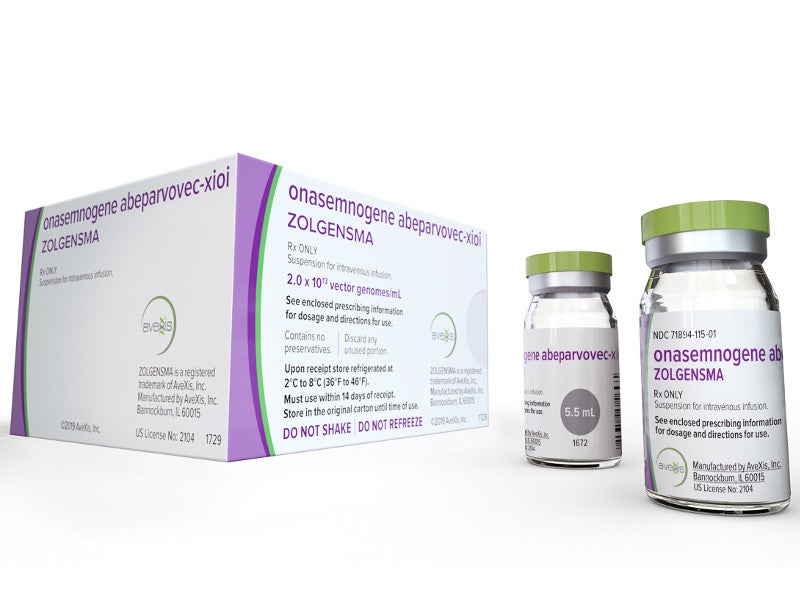

The most expensive drugs in the US: Ranking the top five
- Spinraza (nusinersen) –$750,000 first year and $375,000 thereafter
- RAVICTI (glycerol phenylbutyrate) – $793,632
- Luxturna (voretigene neparvovec-rzyl) – $850,000
- Exondys 51 (eteplirsen) – between $750,000 and $1.5m
- Zolgensma – $2.12m
Spinraza (nusinersen) – between $375,000 and $750,000

Developed by Ionis and Biogen, Spinraza is approved for the treatment of spinal muscular atrophy (SMA) caused due to mutations in the 5q chromosome of the SMN1 gene in paediatric and adult patients. The absence of the 5q chromosome leads to the deficiency of the SMN protein, which is responsible for the production of motor neurons and motor functions.
Spinraza costs $750,000 for the first year of treatment, followed by $375,000 in sunsequent years. The price of the drug has been considered to be too high with the Institute for Clinical and Economic Review (ICER), a non-profit organisation, suggesting the price to be benchmarked between $72,000 and $130,000 for the first year of treatment, and $36,000 to $65,000 a year thereafter.

US Tariffs are shifting - will you react or anticipate?
Don’t let policy changes catch you off guard. Stay proactive with real-time data and expert analysis.
By GlobalDataSpinraza works by binding to the SMN2 gene, which is identical to the SMN1 gene to produce a full-length SMN protein. It thereby increases the production of functional SMN protein in patients.
RAVICTI (glycerol phenylbutyrate) – $793,632

RAVICTI is a nitrogen-binding agent approved for the treatment of chronic management of urea cycle disorder (UCD) in adults and children. UCD is a rare genetic disorder caused by an enzyme deficiency in the urea cycle, a process that converts excess ammonia from the bloodstream and eliminates it from the body.
Developed by Horizon Therapeutics, RAVICTI costs $793,632 for a year of treatment. Horizon also provides the drug through its Horizon Patient Services programme. Since the original approval in 2013, the drug has received supplemental approval for patients aged two months and older and is a standard treatment for UCD.
RAVICTI is a triglyceride belonging to the nitrogen scavenging class of drugs. It works through an alternative pathway to the urea cycle to enable nitrogen disposal.
Luxturna (voretigene neparvovec-rzyl) – $850,000

Luxturna is a one-time gene therapy indicated for the treatment of inherited retinal dystrophy due to mutations in both copies of the RPE65 gene. Inherited retinal dystrophies are a group of rare disorders caused due to more than 220 types of genes. The disorders lead to night blindness, involuntary eye movements (nystagmus), loss in their peripheral vision, tunnel vision and, eventually, blindness.
Developed by Spark Therapeutics, Luxturna is available at an annual cost of $850,000 or $425,000 for each eye. The price of the drug is too high and should be within the range of $153,000 and $217,000, according to the ICER’s estimates.
Spark Therapeutics has developed a contracting model for providing the drug to patients. Under the model, the company enters an agreement with commercial payers who purchase the drug instead of a treatment centre. The payers reimburse the facility to deliver the specialised medical care required as part of the treatment.
Exondys 51 (eteplirsen) – between $750,000 and $1.5m a year

EXONDYS 51® is indicated for the treatment of Duchenne muscular dystrophy (DMD) in patients with DMD gene mutation amenable to exon 51 skipping. DMD is a rare progressive disease caused due to one of more than 2,000 mutations of the dystrophin gene. The disease leads to progressive loss of skeletal and cardiac function and ultimately death.
Developed by Sarepta Therapeutics, EXONDYS 51® is estimated to cost between $750,000 and $1.5 million a year. Several advocacy groups have urged the US Department of Health and Human Services to reduce the price of the drug as high costs make the drug inaccessible to many patients.
EXONDYS 51® is an antisense oligonucleotide of the phosphorodiamidate morpholino oligomer, which is synthetic molecule. The drug works by binding to exon 51 of the dystrophin gene, enabling the exclusion of the exon during messenger ribonucleic acid processing in patients.
Zolgensma (onasemnogene abeparvovec-xioi) – $2.1m

Zolgensma is the first gene therapy approved for the treatment of SMA with bi-allelic mutations in patients aged less than two years. SMA is a rare genetic disease caused due to defective or missing SMN1 gene, which is responsible for the production of the SMA protein that is required for the maintenance of motor neurons and motor functions in the body.
Developed by AveXis, a Novartis company, Zolgensma is a one-time treatment that is available under a pay-over-time model at an annualised cost of $425,000 for a period of five years. The treatment costs $2.125m in total and is designed to replace lifetime chronic therapy that can exceed $4 million.
AveXis is also offering a support programme named AveXis’ OneGene Program™, which provides individualised support to patients through the course of the treatment. The ICER, however, suggests that the drug price should be benchmarked between $310,000 and $900,000 per treatment.
Zolgensma delivers a functional copy of the SMN1 gene to halt the disease progression.
Cell & Gene Therapy Coverage on Pharmaceutical Technology supported by Cytiva.
Editorial content is independently produced and follows the highest standards of journalistic integrity. Topic sponsors are not involved in the creation of editorial content.




